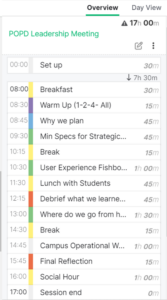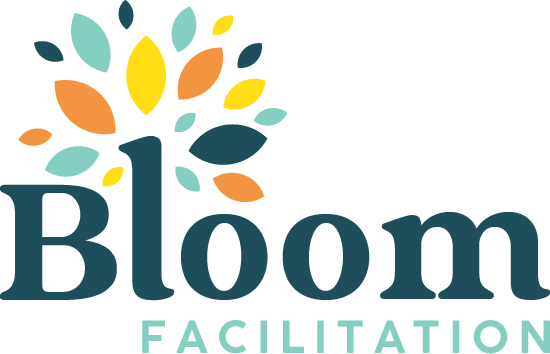This case study highlights how we helped a university leader design and facilitate a strategic planning session with their department’s leadership team.
The Client and the Problem
Tony Smullen, Chief of Staff for UC Merced’s Physical Operations, Planning, and Development Department, approached me with a challenge. They had been so busy with the semester and time was running out to get their leadership team together for a strategy meeting before everyone left for the holidays. I had already had an opportunity to work with Tony and his team the previous semester. One of the goals that the team had identified in the Spring was the importance of working collaboratively and they wanted to meet as a leadership team on a regular basis in order to move their big strategic goals forward.
But you know how it is, everyone is understaffed right now and the semester was almost over without a chance to gather and plan. Tony had managed to find a date on everyone’s calendar and reserved a great offsite location, but he was concerned that he wouldn’t have time to design the full day meeting to make the most of everyone’s time.
Also, the University was talking about the importance of strategic planning and Tony wanted to see if this meeting could be a way to kick that off. And maybe use chatGPT?
What We Did
I was excited to support Tony and his team from afar by helping him with meeting design and preparation. He would facilitate the meeting. This was a great way to grow his knowledge, skills and confidence in that role of leading the team meetings while also acknowledging his limited bandwidth for meeting design and prep.
I met with Tony and his supervisor Dan via Zoom and together we articulated the key desired outcomes for the meeting. This is a crucial first step in meeting design and often it is the hardest step. In most cases there are many things you would like to see happen in a meeting, so it is important to get clear about what is the most important outcome that the meeting needs to achieve.
Next, I outlined an agenda/design for the meeting that would do 2 things.
- It would achieve the desired outcome.
- It would manage the group’s energy.
This was set up as an all day meeting, so it was important to take into consideration which types of interaction could drain the group’s energy and how to include breaks and different styles of communication.
I used a tool called Session Lab to document the meeting design. This tool is great because it makes timing easy and allows for flexibility if you have to switch sessions around. Since I was preparing the meeting but not facilitating, this was also a great way to collaborate with Tony. I was able to give him direct access in Session Lab so that everything he needed, including visuals and instructions, was organized in one place.

Overview Agenda from Session Lab
The actual activities we chose to include were:
Liberating Structures for Strategic Planning
1-2-4-All
This method is flexible and easy to use. I’ve taught this to other groups and recently heard back from one client that this is their go to method when they want to engage everyone in a meeting.
User Experience Fishbowl
UC Merced is very focused on serving students and being student driven. It made sense to invite students into the leadership meeting and hear directly from them. This method is a great way to get authentic insights from your “users”.
15% Solutions
Often in planning we face the roadblock of “if only we had more money” or “if only we had more staff”. It is important to plan for how to grow your capacity and resources, but it is also important to figure out how you can operate in better alignment with your mission and values with your existing resources. That is what 15% solutions is focused on and that is why we chose this method for the afternoon. In long term planning it is useful to mix ideas for the future with ideas that you can actually implement right away.
What, So What, Now What?
This is another popular and simple method that repeats the 1-2-4-all structure, but with a focus on the learning-action cycle. The idea behind it is that we need to build in time to reflect on what we heard and observed, what we learned from that new information and what actions we want to take based on what we learned. So often we have a meeting in which we get a lot of new information, ideas, or insights, but we don’t allow for time to process and implement.
Why We Plan Learning Activity based on Sightline by Rebecca Sutherns
I admire Rebecca Sutherns work on strategy and planning. She has a new guide, Sightline, that helps leaders to understand how to build a strategic plan that will be actionable, rather than just gather dust on a shelf.
When we are starting a new strategic planning process, it is important to keep in mind that leaders come with a lot of experience having done planning in the past. Some of those plans may have required a lot of time to create and then never got used. This is unfortunately quite common. Therefore, we wanted to engage the group in a discussion about the benefits of strategic planning and get the group to define why they want to plan and what they hope to get out of it. Often a planning process is initiated based on a directive from above or based on an arbitrary time clock. It is critical that the leaders who are developing the plan have an opportunity to define what they want to get out of the planning process and how a strategic plan will help them and their work before they begin.
ChatGPT for Strategic Planning
Remember that Tony had asked about chatGPT? Some of the people on his team were starting to use this AI tool to be more efficient with their writing. I had been running a lot of experiments with different ways to use it and I loved the challenge of how we could use it for Strategic Planning. I ended up trying out a few prompts with my own account and then recorded a demo video for the team. Tony delegated this section to the team member who had used it the most and they were able to ideate with chatGPT together in the meeting. It was a fun and useful energy boost in the afternoon.
The Results
Tony successfully facilitated an all day engaging leadership team meeting for his department. He and his team had a chance to practice new ways of interacting with one another and with students that enabled more collaboration and greater connection and creativity.
In terms of tangible results, they received actionable feedback from students. In fact, they were able to put the student’s ideas into practice within weeks of the meeting. They also got a solid start on the strategic planning process, which positions them well to respond to the request from the President’s Office to create a departmental plan that aligns with the University plan. Finally, they met their goal of gathering as a leadership team. Since it was a positive and productive experience it will help them make this a regular occurrence instead of something that everyone puts off or avoids.
Bloom Facilitation Strategic Planning Services
As a seasoned facilitator specializing in process facilitation, I offer meeting design and coaching tailored to your needs, as demonstrated with Tony’s experience, or serve as a neutral facilitator for your group. Whether guiding groups through planning processes over months or facilitating large meetings like employee retreats, my approach ensures maximum engagement and optimal outcomes. Click the contact tab in the upper right corner to inquire or ask questions.

Sharon Tewksbury-Bloom, Bloom Facilitation
